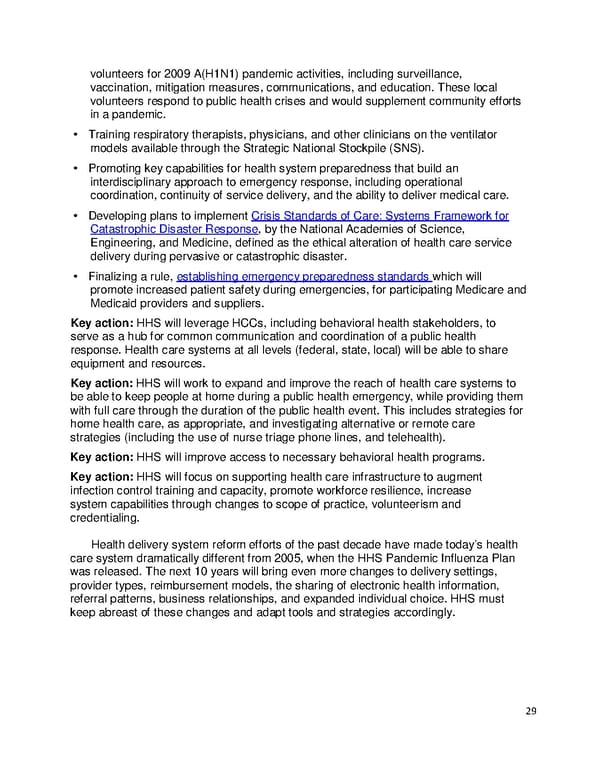volunteers for 2009 A(H1N1) pandemic activities, including surveillance, vaccination, mitigation measures, communications, and education. These local volunteers respond to public health crises and would supplement community efforts in a pandemic. • Training respiratory therapists, physicians, and other clinicians on the ventilator models available through the Strategic National Stockpile (SNS). • Promoting key capabilities for health system preparedness that build an interdisciplinary approach to emergency response, including operational coordination, continuity of service delivery, and the ability to deliver medical care. • Developing plans to implement Crisis Standards of Care: Systems Framework for Catastrophic Disaster Response, by the National Academies of Science, Engineering, and Medicine, defined as the ethical alteration of health care service delivery during pervasive or catastrophic disaster. • Finalizing a rule, establishing emergency preparedness standards which will promote increased patient safety during emergencies, for participating Medicare and Medicaid providers and suppliers. Key action: HHS will leverage HCCs, including behavioral health stakeholders, to serve as a hub for common communication and coordination of a public health response. Health care systems at all levels (federal, state, local) will be able to share equipment and resources. Key action: HHS will work to expand and improve the reach of health care systems to be able to keep people at home during a public health emergency, while providing them with full care through the duration of the public health event. This includes strategies for home health care, as appropriate, and investigating alternative or remote care strategies (including the use of nurse triage phone lines, and telehealth). Key action: HHS will improve access to necessary behavioral health programs. Key action: HHS will focus on supporting health care infrastructure to augment infection control training and capacity, promote workforce resilience, increase system capabilities through changes to scope of practice, volunteerism and credentialing. Health delivery system reform efforts of the past decade have made today’s health care system dramatically different from 2005, when the HHS Pandemic Influenza Plan was released. The next 10 years will bring even more changes to delivery settings, provider types, reimbursement models, the sharing of electronic health information, referral patterns, business relationships, and expanded individual choice. HHS must keep abreast of these changes and adapt tools and strategies accordingly. 29
 Pandemic Influenza Plan Page 28 Page 30
Pandemic Influenza Plan Page 28 Page 30